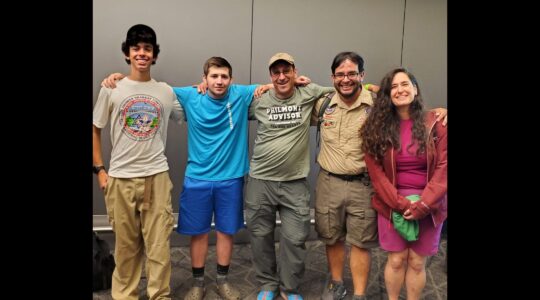GIRONA, Spain, July 30 (JTA) “Sepharad is your home.”
Those soothing, welcoming words were pleasant to hear, especially from a non-Jewish Spanish official, the head of tourism in the small town of Castello d’Empuries in Catalonia in Spain’s northeastern corner.
“Spain is your home,” the official had said, using the Hebrew word “Sepharad,” a symbolic reminder that 500 years of exile had not dimmed the memory of Spain’s Jewish past.
An hour’s drive from Castello d’Empuries lies the bustling, hilly town of Girona, where the cathedral bells toll the hour in a manner reminiscent of a Hemingway or Orwell novel. At the same time, near the cathedral walls and in the open courtyard of a recently opened Jewish study center and Jewish Museum on the site of a 13th-century synagogue a panel of Catalan journalists, writers, professors and an Israeli consul discusses “Poetry, Literature and Hebrew Letters in the 20th Century.”
A few towns away, in the medieval village of Besalu which appears to have stepped out of the pages of King Arthur and his Knights of the Roundtable hundreds of tourists walk each day down a flight of dark and damp steps to what may be the only ancient mikveh in Spain. Unused now, the bath once served a ritual function in a country that during the Middle Ages contained several hundred thousand Jews, half of all world Jewry.
In Besalu, the Spanish guides explain the purpose of the ritual bath and tell the story of what most Jews already know as “The Golden Age of Spain.” It is of that age, especially in small towns, that the Jewish experience, presence and places of worship are being revived and restored.
About 14,000 Jews, mostly in Madrid or Barcelona, still call Spain home. There are no Jews, however, in Castello d’Empuries, Girona, or Besalu.
Spain is no exception to the European phenomenon whereby non-Jews care for and preserve Jewish sites. Driven and organized in most cases by non-Jews and financed by municipalities, the central government in Madrid and even the European Union the rediscovery includes not only uncovering a mikveh or locating a synagogue, but also discovering former Jewish homes by detecting the carved doorpost niches where mezuzahs once hung; collecting and preserving tombstones; or saving and restoring 500-year-old Hebrew parchments.
Officials hope that restoring Jewish sites will attract Jewish and non-Jewish travelers interested in learning about Spain’s Jewish past.
But that is not the only reason for the country’s interest and expenditure in rediscovering its Jewish past.
Spain still is struggling to understand its own history, including recent fascist decades, its bloody civil war of the 1930s, the terror of the medieval Inquisition, the Jewish expulsion of 1492 and the battles with the Moors.
In other words, reconciliation is the word in 21st-century Spain.
In booklets and documents, Spanish officials point out that “their history would be incomplete without the history of the Jewish community.”
“The expulsion,” these pronouncements say, “could not choke the deep roots which they” the Jews “left behind in our towns and cities and which are being duly invoked and praised in this country.”
To that end, 10 Spanish municipalities recently formed a network that declared that the “Jewish legacy constitutes one of the basic pillars of their history and a characteristic element of their heritage.”
Barcelona and Madrid soon will be added to the network.
The organization is known as “Red de Juderias de Espana Camino de Sefarad,” or “The Network of Jewries of Spain Paths of Sepharad,” and is known popularly as the “Red Network.”
Members of this chain include some of the most beautiful and historical towns in Iberia, each one almost a museum in its own right, infused with Old World charm and dedicated to uncovering its Jewish past.
Mere mention of the names of these towns Caceres, Cordoba, Girona, Hervas, Oviedo, Ribadavia, Segovia, Toledo, Tortosa, Tudela recalls the former life in the Juderias, or Jewish neighborhoods, throughout Spain.
These networks have uncovered gravestones, a mikveh, Hebrew letters inscribed in church walls, former sites of synagogues, and hundreds of Jewish streets. They have erected plaques and statues to Jews who thrived here and contributed much to Spain as teachers, writers and poets, among them Maimonides, Nachmanides and Judah Halevi.
But this digging into the Jewish past is not limited to relics or museum displays. Concerts of Hebrew and Judeo-Spanish songs draw large audiences.
For example, in Hervas, in western Spain, a lecture on “Jewish Urbanistic Heritage,” is held. In Toledo, in the El Transisto Synagogue, a dramatized reading of the “Songs of Songs” takes place. Training courses on “The Jewish Inheritance in the Network of Jewries” are conducted.
In terms of Jewish history and Jewish preservation, Gerona is the pearl in the oyster. At the top of its list of accomplishments and goals is the rebuilding of its Jewish quarter, or Call, which means an urban area inhabited by Jews.
With its labyrinth of alleyways and narrow passages, visitors feel the presence of a former Jewish community in one of Europe’s best-preserved Jewish quarters. Located in the heart of the town’s historical center, the narrow, cobblestoned street once was the main thoroughfare of the Jewish quarter, and was known in the 14th century as “Carrer Major del Call.”
Girona was the first kabbalistic center in Spain and eventually became the most important kabbalistic and philosophical center of Western Europe. Known also as “the Mother Town of Israel,” it was home to the great 13th- century sage Nachmanides, or Rabbi Moses Ben Nachman. Known by the acronym Ramban, he was the most outstanding kabbalist and talmudic authority of his day. Bonastruc ca Porta is Catalan for Nachmanides.
In 1263, Ramban represented the Crown’s Jewish communities in the historic Barcelona Disputation with the convert from Judaism, the Dominican Pau Cristia and won.
It is in the Call’s streets that Nachmanides walked and prayed. There, the Municipality of Girona and other agencies and institutions created the Bonastruc ca Porta Center, whose director is the energetic Assumpcio Hosta i Rebes, historian and administrator of the “Red Network.”
Under her guidance, the Museum of the History of the Jews of Catalonia, and a research facility called the Nachmanides Institute for Sephardic and Kabbalistic Studies were established. Assumpcio reports that 150,000 visitors toured the museum in 2000.
The City of Girona itself has contributed more than $1 million to the restoration and the establishment of the museum. Funds have been received from the Spanish government, the European Union and The American Friends of the Girona Museum, which is based in New York.
The institute, which provides residences on the premises for scholars and historians, seeks funds to enlarge its library, its research facilities, its museum collection, its restorations, its public Hebrew classes and its forums and seminars.
Near Girona, on a windswept hillock in the town of Portbou at the French border, is the grave of and memorial to Walter Benjamin, the 20th-century German Jewish philosopher, writer and art reviewer who committed suicide in 1940 when he wrongly thought he would be returned to the Nazis in Vichy France. He wrote that “it is more arduous to honor the memory of the nameless than that of the renowned.”
Some might say that the work now being done in Spain, away from the beaten path, goes a long way toward honoring those nameless Jews exiled in 1492.
Ben G. Frank is the author of “A Travel Guide to Jewish Europe” and “A Travel Guide to Jewish Russia and Ukraine.”
JTA has documented Jewish history in real-time for over a century. Keep our journalism strong by joining us in supporting independent, award-winning reporting.





